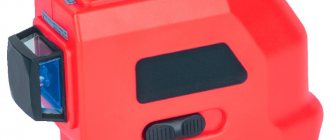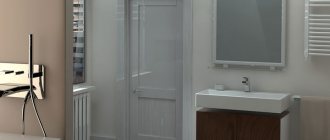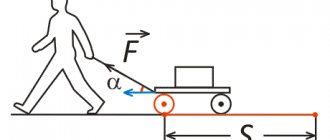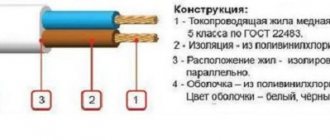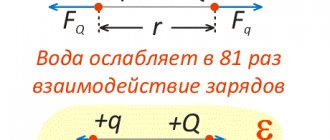A chipping thread is a construction tool used to make straight-line markings on the surface of walls, ceilings or floors. Popularly, among various construction specialists, this marking tool is also called: tapping cord, construction cord, painting cord, marking cord, lace, marker thread or coloring cord.
Chop cord, also known as paint cord or break thread.
How to work with chop cord?
Now, using an example, let’s look at the principle of operation, because before you buy a chop cord, you must know how to use it. First of all, you need to set a task - you need a marking or a plumb line. Let's say you need to mark a surface in a room. First, you need to pour chalk powder into the corresponding hole in the cord. Then, secure the hook of the tool at the point where the marking will begin. Next, you begin to unwind the required length, thereby making preliminary markings. Once you have identified the second marking point, place the chop cord against the surface and hold it firmly. With your other hand, grab the cord, pull it a certain length, feeling a certain tension, and release it, thereby performing a chopping movement. Now, the chalk powder should apparently be imprinted on the surface that you decided to mark. Finally, roll up the cord using the handle and repeat this process as much as necessary. That, in fact, is all you need to know about working with marking cord.
In the case of a plumb line, the situation is even simpler. Place one end of the cord with a hook at the plumb point, and point the body of the instrument down, thereby determining an even plumb line.
Interesting historical facts about the breaker thread
• The first inventor of the breaker thread, like the inventor of the first wheel, is not known to history. However, during historical research, a prototype of a modern marker cord was found in China, dating back to the 3rd century BC. e. That is, this tool was used by the Chinese builders of the Great Wall of China.
• The chemical industry has not always been as developed as it is today, and for many centuries man has used everything as a coloring powder color. For example, even in the era of the USSR, grated red brick dust, blue, lime or chalk powder were often used to tint threads.
Appearance of vintage breaker cords
How to use a marking line
How to use a marking line
It would seem, what could be simpler? But no. In fact, this is a rather exhausting and very responsible job, the quality of finishing and repairs depends primarily on the correct execution of it.
Therefore, when performing precise marking of surfaces, you cannot do without a special device - a tapping cord, which, by the way, is called by many differently: painting cord, marking cord, coloring cord, etc.
How to use the marking cord - how to thread it and apply it correctly in your work - will be discussed in an article on the website https://samastroyka.ru/.
How to thread the marking cord
The chop cord has a very simple design, in the form of a plastic case with a spool inside, for winding and unwinding a long thread. When working with a marking cord, colored dry chalk or special paint is used, which is poured into the body.
It is this that leaves a mark on the surface of the wall or ceiling, from the interaction of the cord with it, during the process of marking work.
To start working with the beating cord, you should definitely check whether it is tucked in color. If there is no paint, then you should refill the marking cord, which requires unscrewing the cap on the body and then pouring the color inside it.
Threading the beating cord should be done every time the marking becomes dull or intermittent.
When threading the marking cord for the first time, you need to proceed a little differently. It is recommended to first pull out the thread completely and only then fill the body half or 3/4 with the coloring composition. Then, having completely wound the thread, the marking cord should be shaken thoroughly, after which it is completely suitable for use.
How to use a marking line
Working with a beating cord is quite easy. After the initial marking of the surface has been made using a hydraulic level or laser level, you can begin marking vertical and horizontal lines.
To do this, the marking cord is pulled between two points (marks) on the wall, after which it is slightly pulled away from the surface and released. If everything is done correctly, then a clear line will appear, which will become the main guideline for attaching the profile, timber and other building materials.
It is advisable to note that it is easiest for two people to work with the marking cord.
When you need to mark alone, you should first drill a hole at the far end of the wall in the place where the mark is. Then you will need to screw the self-tapping screw into the hole using a dowel, after which you can mark it in the manner described above.
How to use the marking cord inside and out
How to use the marking cord - how to thread it and apply it correctly in your work - will be discussed in an article on the website https://samastroyka.ru/.
How much does a breaker thread cost and how to choose it?
The price for construction cord is determined from the following factors:
• Quality of the cord – its strength, length and thickness; • Case material – durable plastic or cheap plastic; • Reel design – direct transmission from the handle to the axis or a gearbox is present in the design.
The cost of a simple beating thread is in the range of 50-200 rubles per thread. The cost of professional beating cords is 500-2000 rubles per set.
Having decided to buy a breaker thread, you immediately need to answer the question with what intensity the tool will be used. If you purchase a marker cord “for yourself,” that is, you plan to use it once every 5-10 years during repairs, then it is enough to buy a marking cord made in China. That is, cheap and cheerful.
The simplest pick-up thread
If you buy a tool for professional construction activities, then, of course, it is recommended to choose a cord from well-known manufacturers. In general, for normal work, a construction team needs a fender thread 30 meters long and 0.5-1 mm thick, consisting of 3-5 twisted fibers. And, of course, when choosing a marker cord, do not forget about the presence of a gearbox in its design, which during professional activities will significantly save time when winding the thread into a spool.
Professional break thread
Algorithm for working with marking cord
The design of the device is quite simple, using the marking cord is also easy.
How to refill
In order for the cord to leave a clear and contrasting mark on the marked surface, the body must be filled with high-quality coloring powder. During the unwinding process, the thread is coated with powder and becomes ready for marking.
In order to fill the body with dye, you need to unscrew the cap covering the loading hole. Powder is poured into it.
Its supply inside the case will have to be replenished whenever the marking line, broken off by the cord, begins to fade.
When using for the first time after purchase, you must completely unwind the thread and fill in the pigment to three-quarters of the volume of the body. Next, the thread is wound up and the device is shaken vigorously. You should not save on purchasing a coloring composition. In Moscow, powder of acceptable quality should not cost less than 80-100 rubles
How to thread the marking cord
Performing markup
First, using a hydraulic or laser level, reference points are placed at the beginning and end of the marked line. Screws are screwed into them or small nails are driven into them. The marking thread is stretched between them. Now you need to take the cord by the middle with two fingers, pull it a little in a direction perpendicular to the surface and the marked line and release it. A clear straight line should appear on the surface. Now you can remove the cord from the markers and move on to marking the next line.
If it is possible to attract an assistant, the work will speed up significantly. No need to attach markers. One presses the beginning of the thread, the other the end. One of the workers pulls back and releases the thread.
Marking with marker cord
How to use a marking cord correctly in specific situations?
To mark gypsum suspended ceilings, you must follow the following recommendations:
- Find the lowest point on the rough ceiling, which will be covered with plasterboard. To do this, use a hydraulic level or level. It will be much more convenient and faster to use a laser level. Its high price will pay for itself many times over due to the time saved.
- At the found level, a mark is made on the nearest wall. Using a level, spirit level or laser level, I repeat the mark twice on each wall.
- The beginning and end of the marking cord are recorded using the marks set; it should fit snugly to the surface.
- Take the thread by the middle with two fingers, pull it a little and quickly release it. After impact, the paint powder leaves a smooth mark on the wall.
- The operation is repeated on the remaining walls.
The broken contour will serve as a guide for installing the starting guide profile, to which the suspended ceiling will be attached.
If the room has an imperfect shape, deviating from a regular rectangle, then when laying ceramic tiles on the floor, even rows will emphasize this. In one corner the wedge will be clearly visible. To disguise such a defect, the tiles are laid diagonally.
Marking with marker cord
To apply diagonal markings to the screed under a ceramic tile floor, proceed as follows:
- The marking cord is pulled between the corners of the room at a height of 5-10 mm from the surface of the subfloor and the main diagonal is marked.
- The cord is stretched between the other two corners and the second diagonal is beaten off.
- The intersection point of the two lines will mark the geometric center of the room;
- From it, on both sides along the main diagonal, the first two rows of tiles should be laid out, using centering crosses to maintain equal distance and spacing.
Next, the rows of tiles are laid from the center to the auxiliary corners, using the first two rows as reference ones.
What is the marking cord used for?
Today, this is a small marking tool with an interesting design and details. Let's start with the fact that in its shape and structure, the chop cord is very much reminiscent of a construction tape measure. It also has a round shape, inside which a cord is wound (in the case of a construction tape, a flexible ruler is wound). But this, perhaps, is all that unites them. Otherwise, these are completely different devices that are needed for different tasks.
Using a marking cord, you can perform several functions - use it as a horizontal and vertical marking of surfaces, and also use it as a plumb line. If the cord will be used to mark surfaces, special chalk powder is additionally used. It can come complete with the tool or be purchased separately. In addition, this kind of powder can be made independently.
If the cord is used as a plumb line, the use of chalk powder is not necessary. As for the main structural parts of the tool, in this case, the situation is as follows. The body of the marking cord is usually made of aluminum; it also has a built-in handle with which you can unwind or rewind the cord. Naturally, the kit includes the cord itself, the length of which, in most cases, is about 30 m, as well as a hook at the end of the cord, with which the cord is fixed to a particular surface. There is also a special hole through which chalk powder is poured into the instrument. This hole is closed with a tight stopper, which will prevent moisture and drops of water from penetrating inside.
Some models of the tool also have a felt insert, with which you can control the flow of chalk. This is the simple design of this tool.
Breaker thread design
The base of the marker cord, regardless of the manufacturer or model, is always made in the form of a closed body. The shape of the body can be round, oval or in the form of a triangle with rounded corners. Inside the closed case there is an axis on which a spool with a strong thread wound on it is mounted. The thread outlet from the body is made in the form of a round hole, its diameter exceeding the thickness of the thread by only 0.1-0.3 mm. That is, when unwinding - pulling the thread out of the body, it should unwind with little effort. To rewind the cord, a convenient handle is provided on the body of the tool, connected either directly to the axis of the reel, or transmitting rotation to the reel through a small gearbox.
In addition to the hole for releasing the thread, there is another hole on the body with a sealed plug for pouring color into it. Dry powder of blue, black, red or white is used as a color, depending on the color of the surface the marking will be made on. That is, if the markings are made on a white or gray surface of the ceiling or walls, then naturally the color used is dark, blue, red or black. On dark surfaces, use a pick-up thread filled with white color or chalk powder.
